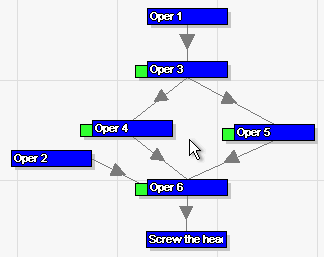An operation has several attributes, some mandatory,
others optional, and can optionally be subject to additional constraints:
-
Mandatory attributes:
-
An operation must have a nonnegative duration.
This is the amount of time it takes to perform the task represented
by the operation. You have the free choice of time units used
to express durations, although they must be whole numbers (floating-point
durations are not accepted). Seconds and hundredths of minutes
are popular time units.
- An operation must be one of the following types: Manual or Robotic.
Manual operations are not allowed to be assigned to a robotic workstation
and vice-versa, for safety reasons.
- Optional attributes:
- An operation can be involved in one or more precedence
constraint(s).
- An operation may require more than one operator
to be carried out (see above). An operation can only be assigned
to a workstation with at least as many operators as the operation
requires.
- An operation can be a variant
operation, i.e., be performed on only a subset of the products being
assembled on the line.
- An operation can have position
constraints.
- Optional constraints:
- An operation can be linked with
one or more other operations.
- An operation can be unmovable,
i.e. fixed to a particular workstation in the line.
- More generally, an operation can be assigned to a zone,
i.e., be constraint to be assigned to one of only a subset of all
workstations.
- An operation can be fixed, i.e.
be forced to be alone on a workstation, although it may be assigned
to any workstation compatible with all its attributes.
|
